Jun 15, 2010 | grading
Numismatic Guaranty Corporation has announced that it has passed the 20 million coins in certified coins. NGC said that it has received submissions from 43 different countries spanning 2,600 years of history. The earliest ancient coin was from as early as 600 B.C.E.
“While 20 million graded coins is a huge accomplishment and we celebrate it, we really are focused on the future,” said Mark Salzberg, chairman of NGC. “We look forward to continuing to push the industry envelope to develop and implement innovations that benefit not only our loyal customers, but the hobby as a whole.”
While this is quite an accomplishment, NGC has to be watching its competition. Over the last few months, the Professional Coin Grading Service has innovated far more than NGC with new services that will benefit the community. While both PCGS and NGC added plus grading to their service to mark premium quality coins, PCGS’s “Big One” that included the PCGS Secure Plus™ service. Coins grade through Secure Plus will be scanned by an optical device that will map the surface of the coin creating a digital signature of its characteristics that can be used for later reference and to compare them with other specimens including the same coin possibly resubmitted.
In addition to Secure Plus, PCGS also introduced the PCGS Coin Sniffer,™ a technology that will recognize the use of chemicals on coins submitted to PCGS. Between the surface and chemical analysis, PCGS is leading the industry in the use of technology to improve on the certification service.
Having been an advocate for the use of technology to assist in the grading process, I feel that this use of technology places PCGS ahead of all grading services. If NGC wants to remain in the top tier of coin grading services, they must integrate technology into their service or risk falling behind.
May 30, 2010 | grading, legal
Late Friday afternoon, Collectors Universe, the parent company of PCGS, announced that they are suing six defendant and 10 “Does” (unknown people) in U.S. District Court for the Central District of California for allegedly doctoring coins. The named defendants are:
- Al Rossman of Nevada
- Eric Steinberg, a PNG member and owner of Broward County Coins in Plantation, Florida
- Rick Wesslink of Mission Viejo, California (it is possible this name is misspelled in the complaint)
- Silvano DiGenova, a PNG member and owner of Tangible Investments in Laguna Beach, California
- Greg Krill, a PNG member and co-owner of North Bay Rare Coin & Jewelry of St. Helena, California
- Robert Lehmann a coin shop owner in Cumberland, Maryland
The complaint alleges that the defendants conspired to doctor coins using “techniques [that] are designed and intended to avoid detection by [PCGS] and the coins’ owners for many years.” Amongst the method allegedly used are chemicals that would show up over time and laser alteration to fix or enhance coins. Owners of doctored coins later received compensation from Collectors Universe under the PCGS Guarantee.
Twelve examples of coin doctoring dating back to 2001 were listed as examples in the complaint.
CU alleges that the defendants are in violation of the Lanham Act (Trademark law) by allegedly misrepresenting the details of the coin; the Racketeer Influenced and Corrupt Organizations Act (RICO) alleging that they knowingly acted as an “enterprise” to defraud CU and PCGS; that the “Defendants acted willfully, fraudulently, maliciously, and in wanton disregard of CU’s rights;” and violated the California Unfair Competition Law.
As part of the complaint, it says that “PCGS is a leading coin authentication and grading service in the world,” and spends several paragraphs describing their work and guarantee. This is followed by the complaint that the defendants doctored coins. However, if PCGS is a professional service, how could they allow these defendants to allegedly submit and they encapsulate coins for over nine years without prior action?
There have been informal discussions in various forums as to whether the third party grading services may becoming overwhelmed with submission and questioning the results of their services. Along with the grading of classic coins, the third party grading services grade many modern coins, some directly from the packaging as shipped to dealers from the US Mint. Could coin doctors use this to try to hide their patterns over the years?
One solution was the formation of a service that verifies the grading of the third party graders. After a very public “spat” between the top grading services and notable dealers, some came together to form the Certified Acceptance Corporation (CAC), an authentication service that verifies the grading of the third party graders. While this may have slowed the coin doctors, it has not eliminated the problem.
In the mean time, PCGS reports that they have paid over $7 million under their guarantee over 24 years. While PCGS should pursue those that attempt to defraud them and the collecting community, PCGS may need to examine its own grading practices to understand how these coins passed their scrutiny.
Apr 11, 2010 | grading, review, technology
Professional Coin Grading Service keeps upping the ante on their PCGS Photograde service. In its latest release, PCGS has added more coin images, new series (e.g., Half Cents, Large Cents, and Half Dimes), and more coin imagess in lower grades. PCGS boasts that there are 1,450 images for Photograde covering almost all coin series. As part of the website service, PCGS now includes their Guidelines for Eye Appeal that includes images to supplement the text.
With the upgrades includes upgrades for the PCGS Photograde for the iPhone app and PCGS Photograde HD for Apple’s new iPad. Since I do not own an iPad (I rarely buy the first release of any product), my review is only for the iPhone app and the website.
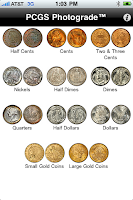 The first thing we find when starting the Photograde app is that it does not put the iPhone in landscape mode. In fact, the entire application will work in portrait or in landscape mode. While a this may sound like a trivial change, iPhone users will tell you that being able to control the how the app is viewed can make the difference between being useful and a nice-to-have app. Being able to be used in portrait mode means I can just hold the iPhone without having to reposition while I use the image to compare with the coin I am looking at. This subtle change is a big plus for this app.
The first thing we find when starting the Photograde app is that it does not put the iPhone in landscape mode. In fact, the entire application will work in portrait or in landscape mode. While a this may sound like a trivial change, iPhone users will tell you that being able to control the how the app is viewed can make the difference between being useful and a nice-to-have app. Being able to be used in portrait mode means I can just hold the iPhone without having to reposition while I use the image to compare with the coin I am looking at. This subtle change is a big plus for this app.
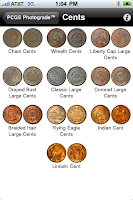 Added to the application were images for half cents and large cents with great images of the coins in the various grades. Even if I will never own a Chain Cent, it is nice to have a clear picture of one to carry around while I walk the bourse floor. Half Cent collectors will also benefit for the adding of those coins. Like all of the other series, the images are clear and can be magnified on the iPhone using pinch motions.
Added to the application were images for half cents and large cents with great images of the coins in the various grades. Even if I will never own a Chain Cent, it is nice to have a clear picture of one to carry around while I walk the bourse floor. Half Cent collectors will also benefit for the adding of those coins. Like all of the other series, the images are clear and can be magnified on the iPhone using pinch motions.
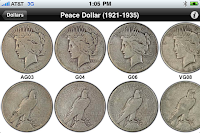 Another nice addition is more coins in lower grades, even for a series like the Jefferson Nickels.. Those who collect coins in lower grades can now determine what the grade of their coin is. Those of us who sometimes buy lower grades because of the higher grade coins are not as affordable, it gives us an idea of how each coin would grade so we can buy it at a fair price.
Another nice addition is more coins in lower grades, even for a series like the Jefferson Nickels.. Those who collect coins in lower grades can now determine what the grade of their coin is. Those of us who sometimes buy lower grades because of the higher grade coins are not as affordable, it gives us an idea of how each coin would grade so we can buy it at a fair price.
Speaking of eye appeal, I found PCGS’s page about eye appeal very interesting. While I like the description, the pictures leave much to be desired. Apparently, PCGS thinks that everyone finds toned coins attractive. With all due respect to PCGS and those fans of toned coins, I am not someone who finds them attractive. Toning is environmental damage. It is the oxidation of the medals (primarily silver) caused by exposure to the elements whether by chance or on purpose. Thus I find the Morgan Dollar they call “Amazing” to be quite a bit less than amazing. In fact, almost all of the coins in the page are toned which I do not find appealing. I understand I may be in the minority in this discussion, but PCGS should recognize that there are collectors with similar views and maybe should consider toned and untoned coins for this section.
Still, the modern coins have been completely omitted from the applications and the website. Jefferson Nickels do not include mint state grading images of the current design, quarters and halves do not include the bicentennial images, and the quarters do not show the obverse of the State Quarters design. As for the dollars, the images end with the Peace Dollars. As I said in the first two reviews, given that there were some circulation of the Eisenhower and Susie B’s as well as striking issues with the Eisenhower dollar, it would be nice to have an image reference of these coins.
PCGS keeps making very good improvements to the website and the iPhone application. For this upgrade, I give both the website and iPhone app a grade of MS68, a premium grade for their new additions but less than perfect for the continued omission of post-1964 coins. PCGS can up this score by adding modern dollars and make it a perfect 70 by adding all modern coin series.
Mar 28, 2010 | grading, technology
This week, the Professional Coin Grading Service announced “The Big One,” a service called PCGS Secure Plus.™ A new service line that will be an option for most collectors except for rare and ultra rare coins which must be certified by PCGS Secure Plus. The significant part of this service is that PCGS is adding modern computer imaging to coin grading.
Coins grade through Secure Plus will be scanned by an optical device that will map the surface of the coin creating a digital signature of its characteristics that can be used for later reference. The digital signature is a unique identification of the coin that can withstand potential coin doctoring and to prevent the users from removing the coin from the slab to try to have it graded higher. It can also be used to determine if the coin was doctored from its previous submission such as being artificially toned.
During the announcement PCGS President David Hall (videos Part 1 Part 2) said that this should end “gradeflation” as well as work out errors in the population reports when people submit coins multiple times. Hall said that multiple submissions did not serve the industry and hope that this would end the practice. Hall noted “We did not start PCGS to grade a coin 40 times.”
Hall said that PCGS has been working on this service for two years with “industry leaders” who were not mentioned. However, in the follow up presentation by PCGS CEO Don Willis (videos Part 3 and Part 4), his technical explanation included an image of the CoinSecure, Inc. to use the CP16 CoinAnalyzer. During his part of the announcement, Willis said that the process is being patented.
CoinSecure, Inc. is a Palo Alto, California based company whose president is Richard M. Haddock. Haddock is the former CEO of the LaserCard Corporation, a company specializing in secure identity solutions that include difficult to counterfeit identification cards and the technologies to detect counterfeit cards. A search of patent records at the World Intellectual Property Organization shows that Haddock has been awarded 16 international patents for various types of optical-related work including for security-related devices. Patents pending for Haddock and CoinSecure are as follows:
| |
Application Number |
Title |
| 1. |
20100039818 |
Numismatic Storage Container To Prevent Counterfeiting Of Coinage |
| 2. |
20090303478 |
Apparatus For Producing Optical Signatures From Coinage |
| 3. |
20090296365 |
Calibrated And Color-Controlled Multi-Source Lighting System For Specimen Illumination |
| 4. |
20090295912 |
Coin Edge Imaging Device |
| 5. |
20090286458 |
Self-Centering Loading, Indexing, And Flipping Mechanism For Coinage And Coin Analysis |
| 6. |
20090284754 |
Method For Optically Collecting Numismatic Data And Associated Algorithms For Unique Identification Of Coins |
As part of the PCGS Secure Plus workflow, coins will be imaged using the CP16 CoinAnalyzer and the data saved in an internal database. Will said that once the coin is imaged, it will go through the normal grading process where it will be reviewed by three graders before being reviewed by a finalizer. Only the finalizer will have access to the digital information and will take appropriate actions.
The Plus
As part of the announcement, PCGS said that it will mark premium quality coins for its grade with a plus as part of the grade. When Willis made the announcement, he said that PCGS has been experimenting with a 700 point grade scale to score a coin based on its technical grading and eye appeal. Coins that grade in the upper end of the grade range will receive the plus. As Hall noted, this will “unlock the value” of better quality coins. Plus grades will be available for grades XF45 through MS68 except for MS60 and MS61.
The plus designation was announced in conjunction with Numismatic Guaranty Corporation. This service will only be available for selected classic series and not planned for modern issues.
More Plus at CCE
As part of the plus designation announcement, Collector’s Universe, the parent company of PCGS, announced that their Certified Coin Exchange market place will offer sight unseen bidding for plus grade coins. Sight unseen bidding means that purchasers will not be allowed to return a coin after auctions through the exchange. Since CCE is an exchange for dealers, it will be interesting to hear what those dealers think of this policy.
An Additional Plus
One understated announcement is that PCGS has updated their holder and added new anti-counterfeiting features to the label. Coins graded as part of the Secure Plus service will be placed in a holder that has a label with a shield. The shield will be printed with a color shifting ink that makes it difficult to duplicate. Color shifting ink is similar to the technologies that are being used on US Federal Reserve Notes. Also, Willis announced that microprinting will appear behind the shield.
Microprinting prevents the vast majority of imaging technologies from being able to duplicate the label. However, PCGS should provide a guideline as to what to look for so that collectors can verify the labels of the coins they buy.
Having been an advocate for computer based grading, this is a great start to using technology to assist in grading. Add the ability to digitally fingerprint the coin to prevent coin doctoring and crackout artists from resubmitting the coins multiple times hoping for better grades, PCGS has created “The Big One” in the world of third party grading.
Feb 6, 2010 | grading, review, technology
On Friday, I connected my iPhone to my computer and opened iTunes to sync everything together. During my sync, iTunes reported that there were application updates. One of the updates was the PCGS Photograde for the iPhone application. Since PCGS upgraded the application and PCGS Photograde website, so quickly after its initial release, I thought an update on the review was in order.
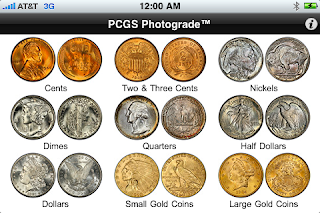 On both the website and the iPhone app, the home page now has entries for “Two & Three Cents” coins and divided the gold into “Small Gold Coins” and “Large Gold Coins.” The full look of the screen looks good and gives the website and iPhone app the impression that it is more complete. Seeing these new images suggests that PCGS added coins from the 19th century coins. But when tapping on the image for the Cents, I saw a full screen of cents starting wit the “Liberty Cap Large Cents” through the Lincoln cent. Not only did PCGS add 19th century coins but they went back to the first coins issued by the US Mint. After looking at the images, I confirmed that my favorite 1794 cent looks like PCGS’s 1796 cent that they grade PO-1.
On both the website and the iPhone app, the home page now has entries for “Two & Three Cents” coins and divided the gold into “Small Gold Coins” and “Large Gold Coins.” The full look of the screen looks good and gives the website and iPhone app the impression that it is more complete. Seeing these new images suggests that PCGS added coins from the 19th century coins. But when tapping on the image for the Cents, I saw a full screen of cents starting wit the “Liberty Cap Large Cents” through the Lincoln cent. Not only did PCGS add 19th century coins but they went back to the first coins issued by the US Mint. After looking at the images, I confirmed that my favorite 1794 cent looks like PCGS’s 1796 cent that they grade PO-1.
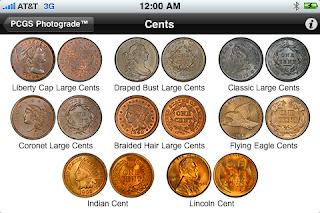 After seeing how far back the images go, it was time to find out how modern PCGS gets. Because of size limitation, the iPhone app does not include years of issue, but the website does. On the website, says that the Lincoln Cent runs 1909 to Date, yet all of the coins imaged were pre-1959 wheat-back cents. There were no images of the Memorial cents nor images of the lowered relief coins. For those looking to put together high grade modern sets it is a serious omission.
After seeing how far back the images go, it was time to find out how modern PCGS gets. Because of size limitation, the iPhone app does not include years of issue, but the website does. On the website, says that the Lincoln Cent runs 1909 to Date, yet all of the coins imaged were pre-1959 wheat-back cents. There were no images of the Memorial cents nor images of the lowered relief coins. For those looking to put together high grade modern sets it is a serious omission.
In fact, after checking other coin images, all of the images of coins that are in circulation today do not have images of modern coins. Jefferson Nickels do not include mint state grading images of the current design, quarters and halves do not include the bicentennial images, and the quarters do not show the obverse of the State Quarters design. As for the dollars, the images end with the Peace Dollars. As I said in the first review, given that there were some circulation of the Eisenhower and Susie B’s as well as striking issues with the Eisenhower dollar, it would be nice to have an image reference of these coins.
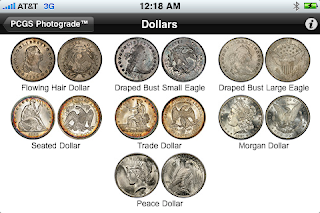 The new images of the added coins are beautiful in all grades. Users of this applications will have a great tool for determining the grade of coins. However, I have the same complaint I made the last time on the use of toned coins. I understand some collectors like toned coins, but the toning does detract from seeing the subtle differences in between high grade coins.
The new images of the added coins are beautiful in all grades. Users of this applications will have a great tool for determining the grade of coins. However, I have the same complaint I made the last time on the use of toned coins. I understand some collectors like toned coins, but the toning does detract from seeing the subtle differences in between high grade coins.
PCGS has taken a great tool and made it even better. I like the iPhone application for being portable when I attend coins shows. For this upgrade, I give both the website and iPhone app a grade of MS67, a premium grade for their new additions but less than perfect for the omission, especially for not including the Eisenhower and Susan B. Anthony dollars.
Feb 4, 2010 | grading, video
Over on the Collectors Society forums, a member cracked out encapsulated coins and posted videos showing how he did this. While I do not advocate cracking coins out of slabs nor do I condone it, the following videos show one person’s method.
Cracking a coin out of a PCGS holder:
Cracking a coin out of a NGC holder:
Regardless of the method you use, please do not hurt the coin. It would be terrible to see a coin destroyed during a crack-out!
Jan 18, 2010 | grading, review, technology
With my background in computers, I love technology. When technology can be used to enhance what we do, I am one of the first people there to participate. This week, I downloaded my first coin-related iPhone application, PCGS Photograde for the iPhone.
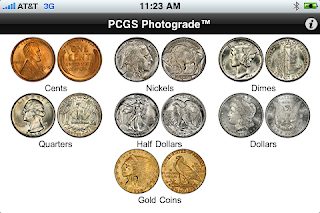 While reading an article reviewing PCGS Photograde website, I noticed they included a banner announcing that the information was available for the iPhone and iPod Touch was available via the iTunes App Store. Excitedly, I clicked the link, read the information, and downloaded the application. After syncing my iPhone with iTunes, the app appeared on my phone.
While reading an article reviewing PCGS Photograde website, I noticed they included a banner announcing that the information was available for the iPhone and iPod Touch was available via the iTunes App Store. Excitedly, I clicked the link, read the information, and downloaded the application. After syncing my iPhone with iTunes, the app appeared on my phone.
Unlike other iPhone apps, PCGS Photograde starts and stays in landscape mode without an option to change that. Even with that minor nit, the app starts right at the home page no splash screen (a good thing), with an image similar to the one on the website. Although PCGS does not use key date coins for the initial image, the coins used do a very good job in representing their section.
 The first limitation I noticed for both the web and iPhone app is that the coins listed were struck in the 20th century. Even if the series started in the 19th century, no series that ended before 1901 was listed. Further, modern coins are not listed unless the series started before the change to clad coinage in 1965. This means that there are no grading images for the Eisenhower, Susan B. Anthony, or Sacagawea dollars. Given that there were some circulation of the Eisenhower and Susie B’s as well as striking issues with the Eisenhower dollar, it would be nice to have an image reference of these coins.
The first limitation I noticed for both the web and iPhone app is that the coins listed were struck in the 20th century. Even if the series started in the 19th century, no series that ended before 1901 was listed. Further, modern coins are not listed unless the series started before the change to clad coinage in 1965. This means that there are no grading images for the Eisenhower, Susan B. Anthony, or Sacagawea dollars. Given that there were some circulation of the Eisenhower and Susie B’s as well as striking issues with the Eisenhower dollar, it would be nice to have an image reference of these coins.
As with the website, the user taps either the obverse or reverse image of the coin representing the series to show a page for you to pick the coin type. One more tap displays the coin in various “common” grades, usually from G04 through MS65. The app shows three images at a time and you can scroll left or right by flicking your finger across the screen. To see the details close up, you can double tap the image you want to see and it will expand to show the entire coin on the screen. If you want to see more detail, use the pinch motion to adjust the size.
 Once you expand the images, you will find that coin images are beautiful. Even when looking at lower grade cents or high grade silver, the images clearly show the criteria for the the grade. The only complaint I have for the images is the use of toned coins. While some people like toned coins, I am not one of them. To me the images with the toning detract from the coins beauty and does tend to obfuscate some of the differences between grades especially Mint State grades which can be difficult without toning. For example, the MS67 and MS68 Kennedy Halves are toned coins which makes it difficult to tell the differences between the two grades.
Once you expand the images, you will find that coin images are beautiful. Even when looking at lower grade cents or high grade silver, the images clearly show the criteria for the the grade. The only complaint I have for the images is the use of toned coins. While some people like toned coins, I am not one of them. To me the images with the toning detract from the coins beauty and does tend to obfuscate some of the differences between grades especially Mint State grades which can be difficult without toning. For example, the MS67 and MS68 Kennedy Halves are toned coins which makes it difficult to tell the differences between the two grades.
One advantage the iPhone app has over the website is that while viewing coin images there is a button to back up one page. On the website there is a “[home]” link. Although you can go back a page by using your browser’s navigation buttons, having a “go back” link would be helpful.
Both the Web site and iPhone app are very useful. But I like the iPhone application for being portable and being able to come with me to shows or coin shops to help me with coin grading. I give both the website and iPhone app a grade of MS64, a common high grade for being very well done but could be better.
Sep 22, 2009 | grading, registry sets
In an attempt to try to boost their business, the Professional Coin Grading Service (PCGS) has announced the launch of the “Everyman” category as part of their PCGS Set Registry competition. The main rule of the “Everyman” Collection are classic coins (mostly pre-1964) not grated higher than AU-58 by PCGS.
PCGS has been running their Set Registry since 2001. The PCGS Set Registry will only accept coins graded by PCGS. This is different from Numismatic Guarantee Corporation (NGC) whose registry competition will accept coins graded by NGC and PCGS. No other grading service offers registry sets.
While I do not begrudge PCGS for doing this, it seems like they have created a category for the “best of the rest.” Rather than compete for the best, you can compete for less than the best. It is like awarding someone for mediocrity. It reminds of the movie Meet the Fockers when Bernie (Dustin Hoffman) and Rozalin Focker (Barbara Streisand) were showing off fourth and fifth place ribbons and participation trophies to the over-acheiving Jack Byrnes (Robert De Niro). As I am looking at PCGS’s announcement as if I was looking at it through the eyes of Jack Byrnes.
I am not against registry sets. After all, I have written about my sets and even wrote when a set was called a top ranking set because it became third in its category. By the way, that set is now second in its category!
But why have a second tier competition? The only reason I can think of is that PCGS is trying to encourage more people to submit their coins for grading. There may not be many more higher grade coins to encapsulate, so this could be a reason to encourage those with coins that were not considered cost effective to grade to be submitted.
Who am I to question capitalism? Let’s see how many circulated 1935 Mercury Dimes (valued at $11 in AU58 according to the PCGS price guide) will be submitted for grading at $15 per coin in order for them to be entered in an “Everyman” set.
Apr 19, 2009 | coins, counterfeit, grading, technology
I have been working with computers for over 30 years. During that time, I have watched computers evolve from room-sized systems to smart-phones that can fit in the palm of your hand. To make this point to people I talk with, I hold up my iPhone and tell them that it is more powerful than the IBM System/370 Model 158 that I used in college—using punch cards!
I was reminded how much technology has changed when I read the article The birth … and death of computerized grading. The article recalls the stories of how computers were supposed to revolutionize coin grading and how New York inventor Henry A. Merton received a patent for computerized coin grading.
Merton’s patent claimed that his system could electronically identify, distinguish, and grade coins based on imaging technology of the daya. Using this system, Merton founded what would eventually called CompuGrade. Starting with Morgan Dollars, CompuGrade would use decimalize grading, assigning partial points to a coin, such as MS 64.5.
Limitations of the technology doomed computer-assisted grading almost as quickly as it started.
Imaging technology has greatly improved in the last 20 years. When combined with x-ray, magnetic resonance imaging, and other electromagnetic technologies, computer imaging becomes an indispensable diagnostic tool. Have you ever been through an MRI and watched the computer reconstruct your internal anatomy from those images allowing for a virtual tour of your body? It is amazing technology.
Advances in biometrics that work on the physiological aspects of the body can now determine differences shown by the same person because of biological changes, such as the effect of aging on your hands. High performance imaging systems are being tested for facial recognition and other identification programs to help law enforcement. While this technology is not perfect, it has shown a lot of progress.
Biometrics uses a concept called pattern recognition. Pattern recognition uses previous knowledge or statistics to recognize or match patterns. Pattern recognition uses a scoring system to determine how close a match would be. A real world implementation can be found in Apple’s iPhoto ’09 application that includes a feature called Faces that helps organize photos by who is in the picture. Faces uses pattern recognition to recognize the people. Interestingly, while Apple’s documentation says that Faces works only on humans, users have reported that it can also recognize pets!
The same technologies could be used for grading coins. Since coins are more static than living beings, the computer can recognize the patterns and the scoring system could be translated into a grade for the coin or even find patterns, such as VAM varieties for Morgan Dollars.
Imaging technologies can be programmed to easily tell of a coin has be cleaned or dipped by noting how the light reflects off the surface. Think of how the computer can “look at” a coin and find the cartwheel effect or determine the fine lines that occur when a coin is cleaned or whizzed.
The article mentions that imaging can be used as a fingerprinting of coins to help in counterfeit detection. With Chinese counterfeiters becoming more sophisticated, computer imaging can be use to find these counterfeits. When a coin is determined to be a counterfeit, the die patterns can be saved in order to be used to find other counterfeits. Additionally, chromatography could be another technology to determine whether the gold or silver is from the period or contemporary.
Computers are great tools. Imaging technologies enhanced by computers can do wonderful things. To apply this technology to coin grading and analysis would be a fantastic addition to the industry. Can you imagine being able to take the technology to major shows and for a small fee, provide on sight diagnostics for coins before submitting them to the grading services? Too bad I do not have the money to invest in this. I believe it would be a great tool for the collecting and investing world.
Mar 22, 2009 | grading
In case you had not noticed, and judging by the numismatic press you probably have not, the Independent Coin Grading Company (ICG) moved from Englewood, Colorado to Tampa, Florida on December 8, 2008. I found this out when I visited the ICG web page while checking the links in my last post.
Does it matter?
Since the take over of ANACS by principals at ICG, the swapping of personnel, the difficult move of ANACS to within a few miles of ICG’s headquarters, and the turmoil that resulted, there has been little good news out of either of these services. Other than bloggers and numismatic forum users have decried the rush of ANACS holders on the late night shopping networks, there has been little news out of Englewood.
But does it matter?
In my experience selling coins on online auction sites or to dealers, coins in ICG and ANACS holders are not being taken as seriously as in NGC or PCGS holder. If you do not mind the ICG or ANACS holders, I have a few coins for sale that may be of interest. These coins were graded by ICG and ANACS before the turmoil.
Yea, but does it really matter?
Over the last year, we have seen the rise of the Dominion Grading Service as a credible service. DGS was born out of the ashes out of PCI after its assets were purchased by David Lawrence Rare Coins. As I noted last year, DGS seems to be making progress in quality and acceptability. While DGS may not be thought of as a top tier service because of their lack of longevity in the market, coins in their holders appear to be selling well.
You have not answered my question, does it matter?
In the market of third party grading services, it seems to be a two horse race with PCGS and NGC fighting to expand into more markets and improve encapsulation of modern coins as the supply of rare coins not slabbed may be dwindling. Even with the emergence of Certified Acceptance Corporation as a fourth-party verification service that verifies coins graded only by PCGS and NGC, one can wonder if there is a market for more grading services. Although DGS is making strides to acceptance, it is almost as if they are 20 furlongs behind heading in the clubhouse turn.
Why are you avoiding the question?
I am avoiding the question because there is no good answer. On one hand, competition is good. Competition works to the benefit of the collector who only wants value and accuracy in these services. On the other hand, ANACS and ICG appears to have damaged their reputation to the point of having the market mistrust their holder. In a market where trust in the accuracy and integrity of the service is a key value, ANACS and ICG appears to have done little in repairing their images after the turmoil that began at the end of 2007.
There are a number of books and magazine articles that recommend those new to the coin market to look for PCGS and NCG encapsulated coins, boosting the reputation of these grading services. As these collectors get used to buying PCGS and NGC graded coins and listen while more experience collectors remind them to “stay with the best.” This has caused coins in these other holders to lose value, even though they may grade the same as if they were in PCGS or NGC holder.
It is difficult to surf past the home shopping cable channels and see what appears to be over graded, modern coins in “special” ANACS holders and continue to take ANACS seriously. Although the capitalist side of me says that ANACS has the right to try to make money, the numismatist side of me wonders at what cost? Unfortunately, this is hurting the reputation of ICG because of the concept of “guilt by association,” or in this case, guilt through diassociation.
The survival of ICG and ANACS should matter to the numismatic community. Over the years, both services have proven resilient and have had good successes. But it is difficult to acknowledge their current place in the market when they are not doing much to distinguish themselves and repair their damaged images.
